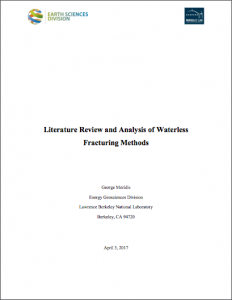Full Title: Literature Review and Analysis of Waterless Fracturing Methods
Author(s): George Moridis
Publisher(s): Lawrence Berkeley National Laboratory
Publication Date: April 1, 2017
Full Text: Download Resource
Description (excerpt):
One of the top water-energy priorities of research on the Chinese side is waterless fracturing using CO2, which was not in the initial CERC-WET workscope on the U.S. side. Thus, while the Chinese CERC-WET team has a strong interest to establish joint R&D activities on using CO2 as the alternative to replace water in hydraulic fracturing, the U.S. CERC-WET has had difficulty supporting a research team because the 2016-2020 funding had already been allocated to individual projects focusing on other objectives. Because non-water fracturing is a timely and high-impact topic for the U.S. as well and it aligns well with the overall CERC objective, the CERC director reached out to DOE/FE for seed funding support. The LBNL received such seed funding to initiate the first step towards designing and developing a productive long-term research collaboration with the Chinese team. The 2016 tasks specified by the DOE/FE are listed below, focusing on analyses of the state-of-the-technology, knowledge sharing with RIPED, and identifying a framework for collaboration.
- Task 1: Conducting analyses of the current state-of-the-art and the application of non-water fluids in oil and gas fracture stimulation, and determining the characteristics of geologic formations amenable to the use of each fluid.
- Task 2: Conducting analyses of CO2-based stimulation techniques and mechanisms, and identifying the key future research questions for large-scale CO2 usage in hydraulic fracturing.
- Task 3: Visit RIPED for exploratory discussions, relationship-building, and knowledge sharing regarding current state-of-the-art using non-water stimulation techniques.
- Task 4: Provide input to RIPED on designing and developing a long-term R&D collaboration to advance the most promising CO2-based hydraulic fracturing techniques.
This report covers the literature review state-of-the-art analyses described in Task 1. Task 2, 3, and 4 results are described in a separate LBNL report (Wan, 2017).
